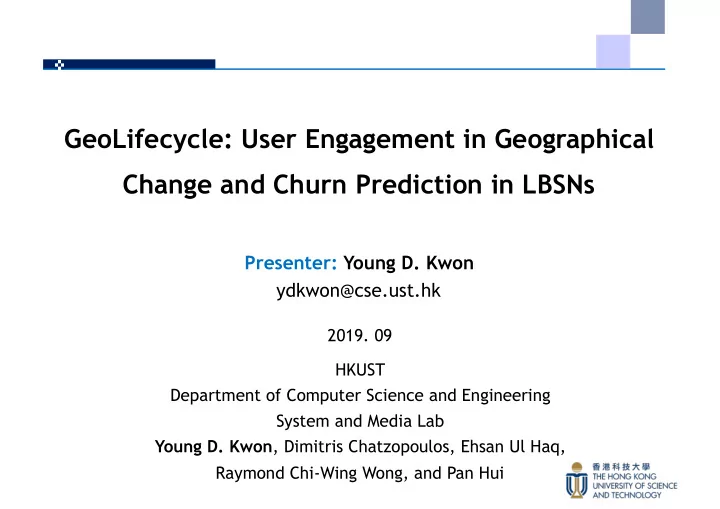

GeoLifecycle: User Engagement in Geographical Change and Churn Prediction in LBSNs Presenter: Young D. Kwon ydkwon@cse.ust.hk 2019. 09 HKUST Department of Computer Science and Engineering System and Media Lab Young D. Kwon , Dimitris Chatzopoulos, Ehsan Ul Haq, Raymond Chi-Wing Wong, and Pan Hui
Why User Engagement and Churn Prediction? ❖ Proliferation of Location-Based Social Networks (LBSNs) • Heavily rely on User Generated Content (e.g., reviews) • Users can stop contributing at any time Analysis: Application: Main Goal: User Churn Maintainability Engagement Prediction Leave or Stay? ✓ 20 important stats and facts, March 2018. URL: https://expandedramblings.com/index.php/by-the-numbers-interesting-foursquare-user-stats/ ✓ Yelp Factsheet, August 2018. URL: https://www.yelp.com/factsheet ✓ 2002. Expert Systems with Applications. Turning telecommunications call details to churn prediction: a data mining approach. Wei and Chiu. � 2 ✓ 2012. WWW. Churn Prediction in New Users of Yahoo! Answers. Dror et al.
Challenges ❖ Limitations Overview of LBSNs • Unclear how users engage with LBSNs � � � � � � Users - LBSNs can capture online and offline experiences of users Reviews Venues � � � � � � � � � � • Effects of various aspects (e.g., temporal, social, linguistics) are not fully studied - Novel Offline Feature : Geographic, Venue-specific features - New Platform (Not studied yet) ✓ 2018. IMWUT. Revisitation in Urban Space vs. Online: A Comparison across POIs, Websites, and Smartphone Apps. H Cao et al. ✓ 2013. WWW. No Country for Old Members: User Lifecycle and Linguistic Change in Online Communities. Danescu-Niculescu-Mizil et al. � 3 ✓ 2015. WWW. All Who Wander: On the Prevalence and Characteristics of Multi-community Engagement. Tan and Lee.
Challenges ❖ Limitations • Less Attention on churning of highly active producer-type users who contribute a majority of reviews ❖ Focus & Scope • Focus on highly active producer-type users • Limit the scope of user engagement to reviewing behaviors ✓ 2018. IMWUT. Revisitation in Urban Space vs. Online: A Comparison across POIs, Websites, and Smartphone Apps. H Cao et al. ✓ 2013. WWW. No Country for Old Members: User Lifecycle and Linguistic Change in Online Communities. Danescu-Niculescu-Mizil et al. � 4 ✓ 2015. WWW. All Who Wander: On the Prevalence and Characteristics of Multi-community Engagement. Tan and Lee.
Examined Research Questions RQ1: How do highly active producer-type users engage in the services of LBSNs in terms of geographical exploration? RQ2: How do engagement patterns of highly active producer-type users manifest themselves in various aspects? RQ3: To what extent can we predict the churning of users with significant contributions within a given period of time? ✓ Yelp dataset: https://www.yelp.com/dataset ✓ Foursquare dataset: Y. Chen, et al. 2018. Measurement and Analysis of the Swarm Social Network With Tens of Millions of Nodes. IEEE Access 5
RQ1 • Geographical engagement patterns: How do highly active producer-type users engage in the services of LBSNs in terms of geographical exploration? t th - : The a verage radius using a user's trajectory up to reviews r g ( t ) Radius over Lifecycle Moving Distance 6
RQ1 • Human life course : will users settle down or keep exploring geographically? - : Distance to define neighborhoods d Immediate Window All Previous Windows 7
RQ2 • How do engagement patterns of highly active producer-type users manifest themselves in various aspects? Venue-specific Aspect Linguistic Aspect Social Aspect 8
RQ3 • Churn Prediction Task: To what extent can we predict churning of users with significant contributions within a given period of time? Classifiers Models (F1) Temporal feature (Baseline) 1. Logistic Regression (LR) (F2) Geographic feature with L2-Regularization (F3) Venue property (F4) Social feature 2. Stacked LSTMs (F5) Linguistic feature (F6) Top2 (based on feature importance) (F7) Top2+Geo2 (F8) All (F9:F15) Leave-one-out 9
AUC RQ3 0.50 0.55 0.60 0.65 0.70 0.75 0.80 0.85 0.90 0.58 0.59 0.62 0.66 10 0.69 0.60 0.60 0.62 0.69 20 0.71 # Reviews 0.60 0.60 0.64 0.70 30 0.72 0.61 0.61 0.66 0.70 40 0.73 0.61 0.61 0.66 0.70 50 0.71 0.77 All-L5 6RcLal 7emSRral 9enue GeRgraShLc LLnguLVtLc 10
AUC RQ3 0.50 0.55 0.60 0.65 0.70 0.75 0.80 0.85 0.90 0.58 0.59 0.62 0.66 10 0.69 0.73 0.60 0.60 0.62 0.69 20 0.71 0.84 # Reviews 0.60 0.60 0.64 0.70 30 0.72 0.85 0.61 0.61 0.66 0.70 40 0.73 0.86 0.61 0.61 0.66 0.70 50 0.71 0.77 0.88 All-L670V All-L5 6RcLal 7emSRral 9enue GeRgraShLc LLnguLVtLc 11
Contributions • Users constantly wander around diverse offline places • The behavioral differences between churners and stayers are significant and are exhibited with their first 10 reviews • LR models based on our findings significantly improve the performance over the baseline on the churn prediction task • We achieve even higher performance in the task by employing a deep learning model 12
Take-Home Messages The average radii and moving distance of users are determined • within 5-10 reviews and stable over their lifecycle More personalized services based on a user's average ➢ radius and moving distance Users constantly write reviews to diverse locations • Recommend to a user different venues located in ➢ geographically different neighborhoods that the user have not reviewed yet • We can accurately predict churning users Gamification techniques such as badges and rewards ➢ could be used to increase engagement levels of users 13
Thank you! Any questions? You can find me at: ydkwon@cse.ust.hk http://www.youngkwon.org/ Young D. Kwon , Dimitris Chatzopoulos, Ehsan Ul Haq, Raymond Chi-Wing Wong, and Pan Hui System and Media Lab, Dept. of CSE, HKUST
Recommend
More recommend